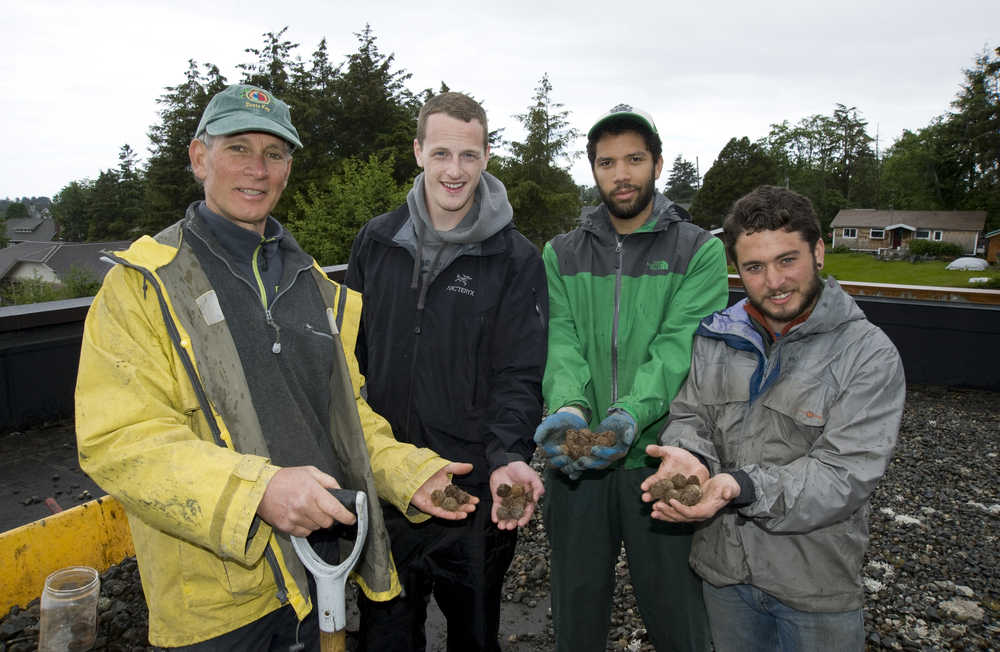SITKA — Roofing volunteers or amateur archaeologists?
The workers on the Hames Center reroofing project thought of themselves as both last week after finding about 20 rusty iron balls, about one inch in diameter, mixed in with the river-run gravel weighting down the old roofing system.
The layer of smooth pebbles that was an integral part of the flat portion of the athletic center’s roof when it was built in the 1980s is being removed as part of the roof renovation now under way. After the workers noticed the metal balls mixed in with the gravel they began speculating on their origin.
The theory now being investigated is that the balls were grapeshot or canister shot fired by cannons in the 1804 Battle of Sitka, and had remained on the bottom of Indian River the next century and a half, until the gravel was dredged out for construction projects
Both grapeshot and canister shot are small metal balls fired as a cluster from a cannon, and having the effect of a shotgun, scattering projectiles over a large area.
Brant Brantman, part-time facilities manager at the Hames Center, is one of the volunteers shoveling gravel off the roof.
“It’s a tedious job,” he said. “For a moment we were just fancying ourselves as archaeologists, not rooftop workers.”
The volunteers were excited when the balls started showing up, and called Brinnen Carter, chief of resources at Sitka National Historical Park, for an opinion. Carter told Brantman and the others that on first glance the iron spheres have markings that appear to be Russian, but that he will have to do further research before he’s sure.
But he did say that the objects appear to be canister shot or grapeshot, based on their size, material and mold markings, called sprue. He said weapons that used this type of shot were commonly found on ships and land-based artillery of all nationalities at the time of the Sitka battle between the Russians and the Tlingits.
Carter, whose master’s thesis was about the arms and armaments of a British warship that sank in Lake Champlain, said he’s in the initial phase of the investigation, and will start by finding out who the contractor was on the last project. He said he’s particularly interested in whether the shot is from the Battle of 1804.
Brantman said he and his wife, Cindy Edwards, first heard about iron balls in the roof gravel from Cindy’s dad, Jere Edwards, in the 1990s, when Jere was a Volunteer in Mission on the Sheldon Jackson College and was working on maintenance projects at the Hames building.
“He told Cindy one of the VIMs found the balls, and the suspicion was that because it was rock that came from Indian River … that they may have been Russian,” Brantman said. “We heard legend of that.”
Cindy Edwards’ nephew Jesse Brantman, the third generation of the Edwards-Brantman family to volunteer at the Hames Center, was the first one to find the iron balls, while shoveling gravel on the roof last week.
Indian River has been off-limits for dredging since the 1940s, when vast quantities of gravel was dredged for military construction around Sitka.
Carter speculated that there may have been stockpiles of this gravel left behind in Sitka after the war. He’s eager to talk to the contractor about the rock source on the Hames Center roof project.
After the first balls started showing up last week, the gravel removal on the roof turned into a bit of a treasure hunt, with volunteers checking every shovelful of gravel. The roof project calls for removal of the old covering on the flat roof areas and replacing the insulation underneath, which had become saturated. Brantman said volunteers are contributing their labor to make the project affordable.
“It’s a bunch of high-functioning people doing days of grunt work – it was good to have some diversion.”
Brantman said he is mostly focused on finishing the roof project, but would certainly like to know more about their find.
“I’m mostly curious to hear what the experts say,” Brantman said.

